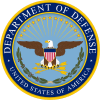
A hospital ship is a ship designated for primary function as a floating medical treatment facility or hospital. Most are operated by the military forces of various countries, as they are intended to be used in or near war zones. In the 19th century, redundant warships were used as moored hospitals for seamen.

Marine Corps Base Camp Pendleton is the major West Coast base of the United States Marine Corps and is one of the largest Marine Corps bases in the United States. It is on the Southern California coast in San Diego County and is bordered by Oceanside to the south, San Clemente and Orange County to the north, Riverside County to the northeast, and Fallbrook to the east.

The United States Navy Nurse Corps was officially established by Congress in 1908; however, unofficially, women had been working as nurses aboard Navy ships and in Navy hospitals for nearly 100 years. The Corps was all-female until 1965.

The Dental Corps of the United States Navy consists of naval officers with a doctorate in either dental surgery (DDS) or dental medicine (DMD) and who practice dentistry for Sailors and Marines to ensure optimal oral health.
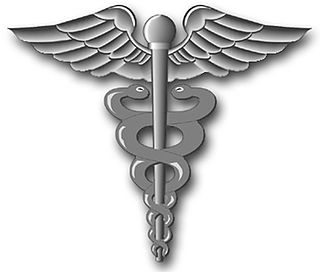
A hospital corpsman is an enlisted medical specialist of the United States Navy, who may also serve in a U.S. Marine Corps unit. The corresponding rating within the United States Coast Guard is health services technician (HS).

Robert Eugene Bush, at age 18, was the youngest member of the United States Navy in World War II to receive the nation's highest military decoration for valor, the Medal of Honor. He was awarded the medal for heroic actions "above and beyond the call of duty" while serving as hospital corpsman attached to a Marine Corps rifle company on May 2, 1945, during the Battle of Okinawa.

Parks Reserve Forces Training Area (PRFTA), commonly known as Camp Parks, is a United States Army base located in Dublin, California, that is currently an active military and training center for U.S. Army Reserve personnel to be used in case of war or natural disaster.

William Beaumont Army Medical Center is a Department of Defense medical facility located in Fort Bliss, Texas. It provides comprehensive care to all beneficiaries including active duty military, their family members, and retirees. The hospital is located in the Central/Northeastern part of El Paso, and provides emergency department services for Northeast El Paso. The current 1.1-million-square-foot, 6-building medical complex opened July 10, 2021 on East Fort Bliss. WBAMC is affiliated with the Paul L. Foster School of Medicine which is also located in El Paso, Texas. WBAMC is also a participating hospital for medical residents from the Uniformed Services University of the Health Sciences (USU) and nursing students from the University of Texas at El Paso School of Nursing and the El Paso Community College Nursing School. The current commander of WBAMC is Colonel Brett Venable.

Walter Reed National Military Medical Center is a United States military medical center located in Bethesda, Maryland. It is one of the largest and most prominent military medical centers in the nation and has provided medical care for several United States presidents since its opening in 1940.

The Alexander T. Augusta Military Medical Center is a United States Department of Defense medical facility located on Fort Belvoir, Virginia, outside of Washington D.C. In conjunction with Walter Reed National Military Medical Center, the hospital provides the Military Health System medical capabilities of the National Capital Region Medical Directorate, a joint unit providing comprehensive care to members of the United States Armed Forces located in the capital area, and their families.
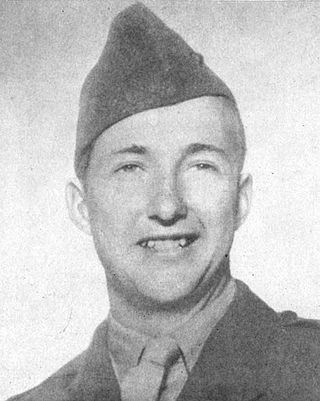
Jack Williams was a United States Navy hospital corpsman who was killed in action while serving with a Marine Corps infantry unit in World War II. He was posthumously awarded the nation's highest military decoration for valor, the Medal of Honor, for heroic actions "above and beyond the call of duty" on March 3, 1945, during the Battle of Iwo Jima.
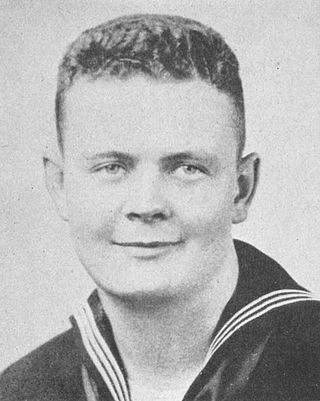
John Harlan Willis was a United States Navy hospital corpsman who was killed in action during World War II while serving with a Marine Corps rifle company. He was posthumously awarded the nation's highest military decoration for valor, the Medal of Honor, for heroic actions "above and beyond the call of duty" on February 28, 1945, during the Battle of Iwo Jima.

United States Naval Hospital Yokosuka Japan with its eight branch clinics are US Navy medical treatment facilities catering to the medical needs of eligible Sailors, Marines, Soldiers, Airmen, family members, U.S. government employees, retired military service members and other eligible beneficiaries of the Forward Deployed Naval Forces on mainland Japan, Korea and Diego Garcia. The core hospital is located on board Commander Fleet Activities Yokosuka with branch clinics serving Naval Air Facility Atsugi, Combined Arms Training Center Camp Fuji, Commander Fleet Activities Chinhae Korea, Naval Support Activity Diego Garcia, Marine Corps Air Station Iwakuni and Commander Fleet Activities Sasebo.
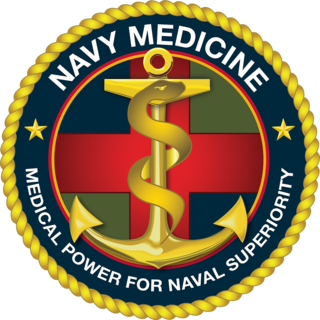
The Bureau of Medicine and Surgery (BUMED) is an agency of the United States Department of the Navy that manages health care activities for the United States Navy and the United States Marine Corps. BUMED operates hospitals and other healthcare facilities as well as laboratories for biomedical research, and trains and manages the Navy's many staff corps related to medicine. Its headquarters is located at the Defense Health Headquarters in Fairfax County, Virginia. BUMED has 41,930 medical personnel and more than a million eligible beneficiaries.

Naval Medical Center San Diego (NMCSD), also known as Bob Wilson Naval Hospital and informally referred to as "Balboa Hospital", or "The Pink Palace" (because the stucco of the first buildings that were constructed was pinkish in color), is a technologically advanced Navy medical treatment facility. Located within the grounds of Balboa Park in San Diego, the hospital has played a role in the history of San Diego for more than 100 years. The goal has remained constant, to provide the finest medical care in a family-centered care environment to operational forces, their families, and veterans. Organizationally, the hospital is first and foremost a military command.
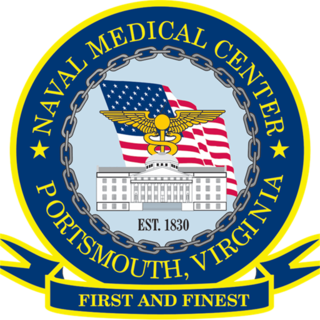
The Naval Medical Center Portsmouth (NMCP), formerly Naval Hospital Portsmouth, and originally Norfolk Naval Hospital, is a United States Navy medical center in Portsmouth, Virginia, United States. It is the oldest continuously running hospital in the Navy medical system.

The Charleston Naval Hospital Historic District is a portion of the Charleston Navy Base that included a collection of buildings connected with the medical needs of the Navy base.

California during World War II was a major contributor to the World War II effort. California's long Pacific Ocean coastline provided the support needed for the Pacific War. California also supported the war in Europe. After the Japanese attack on Pearl Harbor on December 7, 1941, most of California's manufacturing was shifted to the war effort. California became a major ship builder and aircraft manufacturer. Existing military installations were enlarged and many new ones were built. California trained many of the troops before their oversea deployment. Over 800,000 Californians served in the United States Armed Forces. California agriculture, ranches and farms were used to feed the troops around the world. California's long coastline also put the state in fear, as an attack on California seemed likely. California was used for the temporary and permanent internment camps for Japanese Americans. The population grew significantly, largely due to servicemen who were stationed at the new military bases/training facilities and the mass influx of workers from around the U.S. in the growing defense industries. With all the new economy activity, California was lifted out of the Great Depression. Over 500,000 people moved to California from other states to work in the growing economy. California expanded its oil and mineral production to keep up with the war demand.

VA Long Beach Healthcare System, formerly Naval Hospital Long Beach, is a system of Veterans Administration facilities in Long Beach, California and other nearby cities. The main hospital, the Tibor Rubin VA Medical Center, sits on 100 acres of land at 5901 E 7th St, Long Beach. The healthcare system has primary care, tertiary care, and long-term care in areas of medicine, surgery, psychiatry, physical medicine and rehabilitation, neurology, oncology, dentistry, spinal cord injury, geriatrics, blind rehabilitation and extended care.

Naval Hospital Santa Margarita Ranch was a large US Navy hospital facility in Oceanside, California. Located on Camp Pendleton in Camp Pendleton South, California in San Diego County. Naval Hospital Santa Margarita Ranch was the first naval hospital in the area that opened in 1943 to support World War 2 wounded. Built on Rancho Santa Margarita y Las Flores, near the training Center's Lake O'Neill with 1,228 beds. In 1945 the hospital expanded to 1,584 beds. In 1950 the hospital was renamed Naval Hospital Camp Joseph H. Pendleton, Oceanside. The hospital was renamed a few times before being given its current name, Naval Hospital Camp Pendleton, in 1967. The 1943 hospital was built quickly, composed of 76 temporary, wood-frame buildings at first with 600 beds and opened on September 3, 1943. The hospital and support building were on 252 acres. Post war, in 1946 the hospital was reduced to 920 beds. In 1971 construction started on a new eight-story hospital, the new hospital opened in December 1974. The 1974 hospital was replaced with the current hospital in 2014. The site of the original Naval Hospital Santa Margarita Ranch is now: Lake O'Neill Campground, Camp Pendleton Youth Sports, O'Neill Fitness Center, Wounded Warrior Battalion West and the Camp Pendleton Fire Department Station 4.























